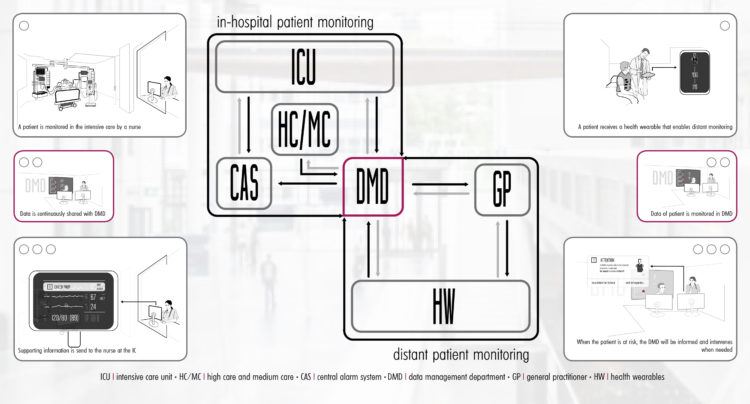First official graduate of CAL
After a period of hard work, Dilip Birdja (Strategic Product Design Master student) graduated on the topic Future Patient Monitoring. With this achievement, he is the very first official graduate of CAL! Dilip established a perspective on future patient monitoring by taking the developments into account that are happening in the health care context, technology and society.
Context
Using patient data will be of vital importance for further advancement of medical practices, in particular for making care more efficient and personalized, which in turn could help to keep health care affordable for everyone. However, the current structure of patient monitoring lacks the possibilities to make optimal use of developments regarding the use of patient data, like health wearables for monitoring from distance or facilitating predictive care by analysing trends in a patient’s health profile.
Within the patient monitoring context, symptoms of this situation are showing in the day to day work of critical care professionals. IC nurses suffer from the abundance in alarms and it is commonly acknowledged that patients – in particular those suffering from delirium – are affected by this too. There could be argued that there is a need for an uncluttered alarm experience for both patients and healthcare professionals. Rules and regulations account for a substantial part of this problem, as they have a big impact on the design of medical devices. However, initiating the much-needed change in rules and regulations is rather difficult, in particular when it comes to using patient data, as there is a delicate balance between sharing patient data and securing patient data.
Future scenario

Developments in the field of hospital care and patient monitoring allow for a structure in which in-hospital patient monitoring and distant patient monitoring are possible. In the scenario above is shown how this could be shaped.
One of the fundamental elements for the scenarios for in-hospital monitoring and distant patient monitoring is the data management department (DMD). In this department, patient data will be managed by qualified nurses and clinicians. With the help of algorithms, they will be enabled to play a supporting role in the monitoring and eventual treatment of patients. Considering the critical care context, the data management department will provide the treating health care professionals with valuable information about the trends in patient data. These trends can tell something about the patient’s condition and help to detect signs of deterioration at an early stage, which is important to prevent further harm for patients.
Outside the critical care context, the department will be responsible for the monitoring of patients that use healthcare wearables. Patients wearing these devices are either at risk of developing (critical) illness or at a stage of recovery, which make them eligible for (intensive) monitoring, however their situation is not severe enough to be hospitalized.
Giving these patients a health wearable could be practical for both health care provider and patient, as monitoring of vital signs is enabled through the wearable, while it has minimal impact on the life of the patient and costs can be reduced significantly as less patients are hospitalized.
Download Dilip’s graduation poster below.